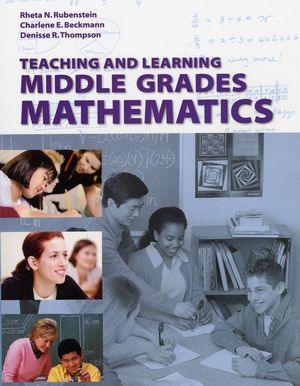|
Textbook
Teaching and Learning Middle Grades Mathematics, with Student Resource CDISBN: 978-0-470-41350-0
Paperback
326 pages
June 2008, ©2004
 |
||||||
Foreword.
Preface and Acknowledgments.
Welcome.
Course Introduction.
Introductory Lesson.
Mathematics Education: Where Do I Stand?
Getting to Know Colleagues: Uniquely Us.
Unit One: A Learning Community.
Mathematics Strand: Reasoning with Patterns and Algebra.
Introduction.
Unit One Investigation: Figurate Numbers.
Preparing to Interview Students about Reasoning with Patterns.
1.1. Problem Solving: Careful Counting.
1.2. Reasoning and Proof: Patterns and Multiplication.
1.3. Generalizing from Patterns: The Concept of Variable.
1.4. Using Experiments: Exploring Graphs and Lines.
1.5. Learning with Materials: Integers and Equations.
1.6. Using Contexts: Functions.
1.7. Using Interviews to Understand Students' Reasoning with Patterns.
Synthesizing Unit One.
Unit Two: The Learning of Mathematics.
Mathematics Strand: Rational Numbers and their Uses.
Introduction.
Unit Two Investigation: Four Fours.
Preparing to Interview Students about Proportional Reasoning.
2.1. Using Multiple Representations: Rational Numbers.
2.2. Using Learning Theory: Fractions, Decimals, and Percents.
2.3. Developing Meanings of Operations: Addition and Subtraction.
2.4. Developing Meanings of Operations: Multiplication and Division.
2.5. Analyzing Student Thinking: Proportional Reasoning.
2.6. Using Interviews to Understand Students' Proportional Reasoning.
Synthesizing Unit Two.
Unit Three: Planning and Instruction.
Mathematics Strand: Geometry, Measurement, and Transformations.
Introduction.
Unit Three Investigation: Historical Formulas.
Preparing to Interview Students about Perimeter and Area.
3.1. Identifying Worthwhile Mathematical Tasks: Measurement Formulas.
3.2. Lesson Planning: Proportions among Measures in Similar Figures.
3.3. Guided Discovery: Quadrilaterals.
3.4. Open-Ended Exploration: Tessellations.
3.5. Integrating Direct Instruction with Guided Discovery: Transformations.
3.6. Effective Classroom Discourse: The Pythagorean Theorem.
3.7. Using Interviews to Plan Instruction on Perimeter and Area.
Synthesizing Unit Three.
Unit Four: Assessment.
Mathematics Strand: Data Analysis and Probability.
Introduction.
Unit Four Investigation: Pascal's Triangle.
Preparing to Interview Students about Their Views on Assessment.
4.1. Multiple Uses of Assessment: Categorical and Discrete Data.
4.2. Assessment That Highlights Students' Thinking: Continuous Data.
4.3. Managing and Grading Every Day: Introduction to Probability.
4.4. Rubrics and Their Uses: Systematic Counts for Probabilities.
4.5. Issues in Developing and Using Tests.
4.6. Using Interviews to Develop a Classroom Assessment Plan.
Synthesizing Unit Four.
Unit Five: Collaborating with Educational Partners.
Introduction.
Preparing to Interview Educational Partners.
5.1. Curriculum Integration.
5.2. Facilitating Educational Growth.
5.3. Evaluating Curriculum Materials.
5.4. Using Interviews to Prepare for Educational Collaboration.
Synthesizing Unit Five.
Appendices.
References and Permissions.
Index.



